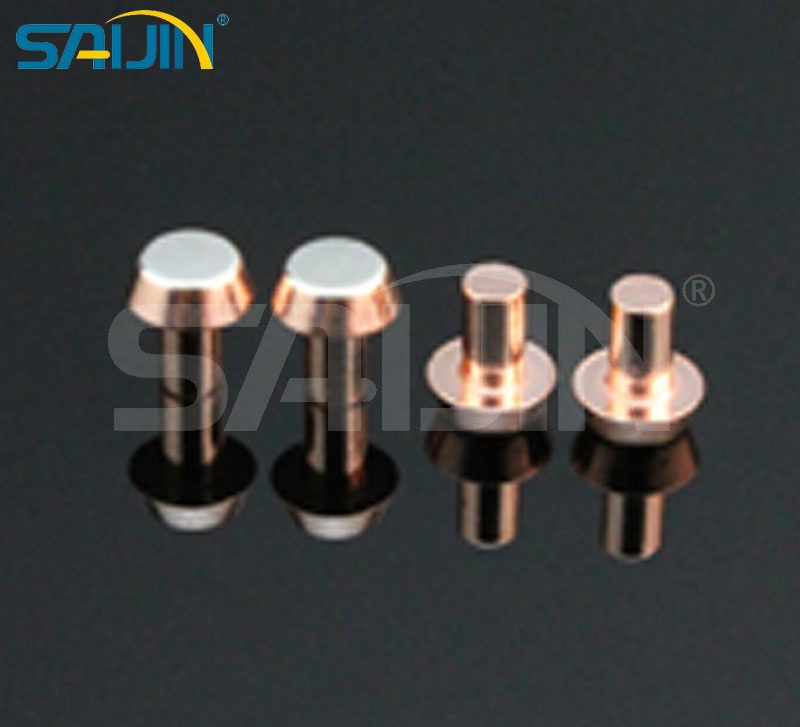How to Test the Performance of Bimetal Rivet Contacts
Bimetal rivet contacts are integral components in electrical systems, and accurately assessing their performance is crucial for ensuring the reliability and safety of these systems. Here are several key methods to test the performance of bimetal rivet contacts.

I. Electrical Performance Testing
A. Contact Resistance Measurement
Contact resistance is a fundamental parameter. A low - resistance measurement system, such as a four - wire Kelvin method, is often used. By passing a known current through the bimetal rivet contacts and measuring the voltage drop across them, the contact resistance can be calculated using Ohm's Law (\(R = V/I\)). A high contact resistance may indicate issues like poor contact, corrosion, or overheating. Regularly monitoring contact resistance can help predict the failure of the contacts. For instance, if the contact resistance gradually increases over time, it could be a sign that the contact surface is degrading.
B. Current - Carrying Capacity Test
To determine the maximum current the bimetal rivet contacts can handle without significant degradation, a current - carrying capacity test is essential. In this test, the current passing through the contacts is gradually increased while monitoring the temperature rise and any signs of arcing or contact deformation. The temperature is monitored using thermocouples attached to the contacts. Once the temperature exceeds a predefined limit or arcing becomes excessive, the maximum current - carrying capacity has been reached. This information is crucial for ensuring that the contacts are used within their rated capacity in practical applications.
C. Insulation Resistance Test
Insulation resistance between the bimetal rivet contacts and the surrounding components is also vital. A high - voltage insulation tester is used to apply a specified voltage (usually much higher than the normal operating voltage) between the contacts and the housing or other adjacent conductors. The measured insulation resistance should be very high, typically in the mega - ohm range. If the insulation resistance is low, it may lead to electrical leakage, short - circuits, or other safety hazards.
II. Mechanical Performance Testing
A. Shear Strength Test
The shear strength of the rivet connection is tested to ensure that the bimetal components remain firmly attached under mechanical stress. A mechanical testing machine is used to apply a shear force parallel to the plane of the rivet. The force is gradually increased until the rivet fails or the bimetal components separate. The maximum force at which this occurs is recorded as the shear strength. A low shear strength could mean that the rivet may come loose during operation, affecting the performance of the electrical device.
B. Fatigue Resistance Test
Since bimetal rivet contacts may experience repeated mechanical stress during their operation, a fatigue resistance test is necessary. This test involves subjecting the contacts to cyclic loading, such as repeated opening and closing motions. The number of cycles the contacts can withstand before failure is recorded. For example, in a relay application, the bimetal rivet contacts may be opened and closed thousands of times. A high - quality contact should be able to endure a large number of cycles without significant degradation.
III. Environmental Performance Testing
A. Temperature Cycling Test
To simulate the effects of temperature changes in real - world applications, a temperature cycling test is conducted. The bimetal rivet contacts are placed in a temperature - controlled chamber. The temperature is then cycled between a low and a high value, such as from - 40°C to 125°C, for a specified number of cycles. After each cycle, the electrical and mechanical performance of the contacts is tested. This test helps to identify any potential problems caused by thermal expansion and contraction, such as cracking or loosening of the rivet connection.
B. Humidity and Corrosion Test
Exposing the bimetal rivet contacts to a humid environment, typically in a humidity - controlled chamber with a relative humidity of around 95%, can reveal their susceptibility to corrosion. Salt - spray tests can also be performed, where the contacts are exposed to a fine mist of saltwater. After the exposure period, the contact surface is inspected for signs of corrosion, and the electrical performance is retested. Corrosion can significantly increase contact resistance and reduce the lifespan of the contacts.
In conclusion, a comprehensive set of tests, including electrical, mechanical, and environmental performance testing, is necessary to accurately evaluate the performance of bimetal rivet contacts. These tests help manufacturers to ensure the quality of their products and users to select the most suitable bimetal rivet contacts for their specific applications.




